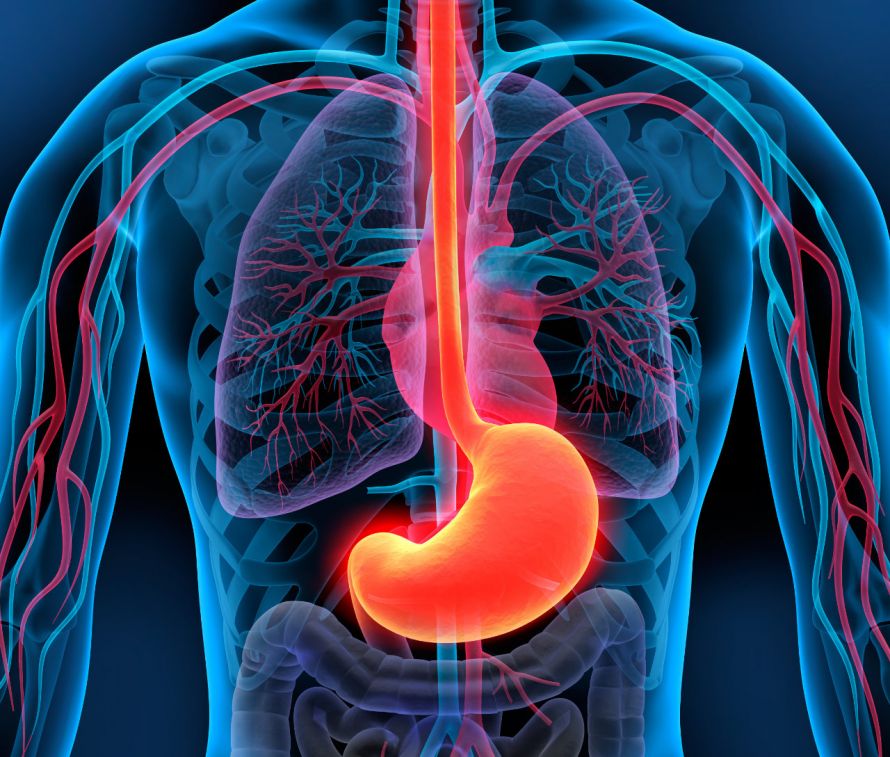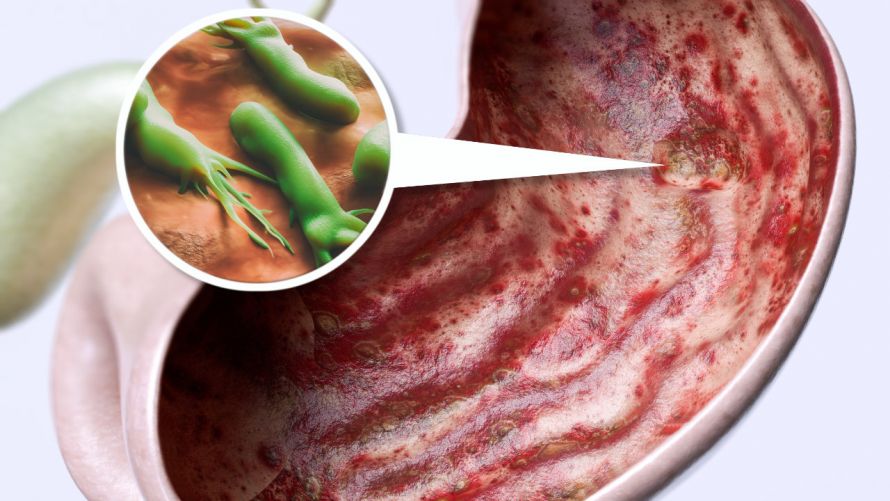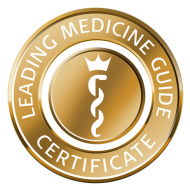A gastric ulcer (ulcus ventriculi) is localised damage of the stomach wall. Every year, about 50 people per 100,000 population develop a new gastric ulcer. Possible symptoms of a gastric ulcer are pain in the middle of the upper abdomen as well as nausea, vomiting heartburn and weight loss. Here you will find further information and selected gastric ulcer doctors and centres.
Recommended specialists
Brief overview:
- What is a gastric ulcer? A relatively common inflammation of the gastric mucosa that can reach into deep layers of the stomach wall.
- Causes: External factors are the bacterium Helicobacter pylori, some medications, too much nicotine and alcohol consumption as well as psychological factors. The body's own factors are increased production of gastric acid and disturbances in stomach movements.
- Symptoms: Feeling of pressure and pain in the upper abdomen, food intolerances, pain when the stomach is empty, nausea, vomiting, heartburn and others.
- Diagnosis: After the anamnesis and the physical examination, a blood test and an X-ray may follow. A gastroscopy confirms the findings.
- Treatment: Medication inhibits acid production and the patient must avoid irritants as much as possible. In rare cases, surgery is necessary if the gastric ulcer does not heal.
- Prognosis: The prognosis is usually good, often the ulcer heals on its own. Drug therapy can treat 90 % of cases. However, the disease often recurs.
Article overview
Definition: What is a gastric ulcer?
A gastric ulcer is also known as a stomach ulcer or also ulcus ventriculi. It is a relatively common disease of the digestive tract. It occurs locally on the stomach wall. In a stomach ulcer, the stomach lining and the deeper layers of the stomach wall are inflamed.
The so-called small curvature, i.e. the small inner curvature of the stomach, is most often affected by a gastric ulcer. But a gastric ulcer can also occur in other parts of the stomach.
Gastric ulcer frequency
Gastric ulcers affect about 50 people per 100,000 inhabitants every year. Gastric ulcer is one of the most common diseases of the digestive tract.
Overall, about 10 per cent of the population will suffer a stomach ulcer at least once in their lifetime.
People between the ages of 50 and 70 are particularly affected. Lebensjahr.

The position of the stomach in the human body © peterschreiber.media | AdobeStock
Causes of a gastric ulcer
A gastric ulcer is always caused by a disturbed balance between
- aggressive influences that damage the gastric mucosa (e.g. gastric acid, bile acid), and
- factors that protect the stomach lining (e.g. sufficient blood flow, mucus production).
Such an imbalance can have various external or endogenous causes.
External (exogenous) factors favouring the imbalance are mainly
- the bacterium Helicobacter pylori,
- the excessive use of medicines such as Aspirin, NSAIDs or cortisone,
- the excessive consumption of nicotine and alcohol, and
- psychological factors such as stress and depression.
Endogenous factors include the following
- increased production of gastric acid and
- disturbances in the movements of the stomach.
Symptoms of a gastric ulcer
The first signs of a gastric ulcer are often a feeling of pressure and pain in the middle of the upper abdomen. This pain can radiate in the direction of the
- Back,
- Breastbone or
- Lower abdomen.
ausstrahlen können.
This pain can be either increased or relieved by food intake.
In addition, those affected often complain about
- an intolerance to some foods and about the
- so-called fasting pains, i.e. pains when the stomach is empty, which occur mainly at night.
In addition,
- Nausea,
- Vomiting,
- Lack of appetite,
- Heartburn and
- Weight loss
are also possible symptoms of a gastric ulcer. For many people, however, a gastric ulcer does not cause any symptoms and therefore remains unnoticed for a long time.
Diagnosis of a gastric ulcer
In order to make a diagnosis, the doctor will first ask the patient about their symptoms during an anamnesis interview. In the subsequent physical examination, the doctor then palpates the upper abdomen of the affected person. If this palpation of the upper abdomen is painful for the person concerned, this can already be an indication of a gastric ulcer.
Other diagnostic methods that can be used are
- a blood test to check certain blood values,
- an ultrasound examination of the upper abdomen (upper abdominal sonography) and
- an X-ray examination of the stomach with contrast medium.
However, a reliable diagnosis of a gastric ulcer can only be made with the help of a gastroscopy). This involves taking tissue samples from the affected area in the stomach. They are then histologically examined in the laboratory.

A gastric ulcer caused by the bacterium helicobacter pylori © crevis | AdobeStock
Treatment of a gastric ulcer
Various forms of treatment are available for a gastric ulcer. They are used depending on the severity and cause of the disease.
Usually, the patient is first given medication to inhibit acid production.
If this does not result in healing or if complications occur, surgery is necessary. Complications can include stomach bleeding or the gastric ulcer breaking through the stomach wall.
Various irritating factors can irritate and damage the stomach lining and promote the development of a gastric ulcer. These factors should be avoided during and after treatment. This includes for example
- Nicotine,
- Alcohol,
- Coffee,
- spicy, fatty and fried foods, and
- certain painkillers such as aspirin.
Medicinal treatment of a gastric ulcer
The medical treatment of a gastric ulcer usually consists of the administration of various acid-inhibiting drugs. These acid blockers are supposed to inhibit the production of gastric acid and in this way
- alleviate the pain and
- contribute to the recovery of the gastric mucosa.
Medicines that are available here include
- Proton pump inhibitors (e.g. omeprazole, pantoprazole) or
- H2 receptor blockers (e.g. cimetidine, rantidine).
If the bacterium helicobacter pylori is the cause of the stomach ulcer, antibiotics are used to kill the bacteria.
Surgical treatment of a gastric ulcer
Drug treatment with acid blockers leads to healing of the gastric ulcer in 90 percent of cases. However, if a gastric ulcer does not heal after several months despite medication or if complications occur, it should be operated on.
There are two different surgical methods to choose from: the Billroth operation (Billroth method) and the selective proximal vagotomy:
- In the Billroth operation, the surgeon removes two thirds of the stomach.
- In a selective proximal vagotomy, the surgeon cuts the vagus nerve. This normally stimulates the acid-forming cells in the stomach.
Prognosis for a gastric ulcer
The prognosis for a gastric ulcer is usually good. In about 40 percent of those affected, the gastric ulcer heals on its own without treatment. The cure rate for those affected who undergo drug therapy is 90 percent.
However, people who have already had a gastric ulcer often develop recurrences. So the ulcer often recurs. Favourable factors for this are above all
- a higher age,
- the male sex and
- taking certain painkillers (e.g. aspirin).













